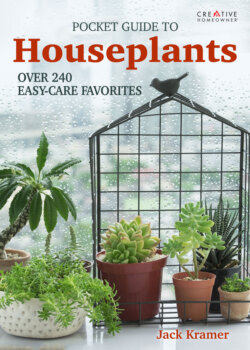Читать книгу Stitching Pathways - Jack Kramer - Страница 16
На сайте Литреса книга снята с продажи.
Color
ОглавлениеHouseplant colors can affect a room’s personality. Color perception is determined by the light that strikes and reflects from surfaces or is absorbed by them. Each color has value, that is, lightness or darkness. Also, a color can be warm, such as red, or cool, such as blue.
When plant color contrasts with wall color, the plant draws the eye, often making a large room feel smaller and more intimate. Consider the drama created by a cascading, brightly colored gesneriad, such as Episcia ‘Flame’, against an off-white wall. If there is no nearby window light, install a spotlight or track lighting.
Conversely, for a small living room, select plants with leaves similar in value and color to the walls; plants that echo room colors make a room seem larger. Another way to create the illusion of greater space is to group plants toward the center of the room. Avoid blocking the traffic flow.
The airy, yellow flowers of this orchid stand out against the deep red wall, providing subtle pyrotechnics and lightening the weight of the heavy furniture.
Color and Light
Houseplants are seen in either natural daylight or in artificial light. The type and quality of that light affect how colors are perceived. Sunlight from a southern window appears warmer than the cool light entering a north window. Day and night also affect color perception, and so do the different types of artificial light. For example, incandescent lamps cast a warmer light than fluorescents.
Choose Colors that Fit the Setting
When adding plants to your decor, choose colors that echo, harmonize with, or contrast with the colors in the room. If your furnishings are of darker wood tones, use dark-valued plants—dark green, purple-green, and blue-green—to create a harmonious look of dark on dark. A burgundy rubber plant (Ficus elastica ‘Burgundy’) or a multicolored maranta would be a good choice. Then you could create dramatic contrast by adding a few light green plants, with yellow-green or apple green foliage, or variegated plants, such as dracaena or coleus.
The color of foliage appears to change in different light. The leaves of this Chinese evergreen are beautifully highlighted in the afternoon sun.
The gold and yellow tones in the foliage of these plants would add zest to any room. The flowering bromeliad (top right corner) has three distinct colors.
There are many shades and tones of green. For example, decorator plant (Dracaena fragrans) has foliage that is almost apple green; the cultivar ‘Massangeana’, known as corn plant, has yellow stripes down the center of the leaves. Dark-leaved plants (look for varieties named ‘Burgundy’ or purpurea) tend to look heavy and massive, whereas plants that have lightcolored leaves, such as arrowhead vine (Syngonium), look quite graceful and airy.
In a room with a yellow color scheme, you might choose houseplants with flowers in harmonizing shades of gold and orange. Yet a spot of bright red could add a striking accent. If you’d prefer a lively, contrasting approach, choose blue and purple blooms for the yellow room. For a quieter, more unified look, choose flowers of a yellow shade that’s close to the other yellows in the room, perhaps augmented with light-green foliage. An elegant, formal room done in white and neutral wood tones would be enhanced by deep-green foliage plants and perhaps blue or white flowers.
